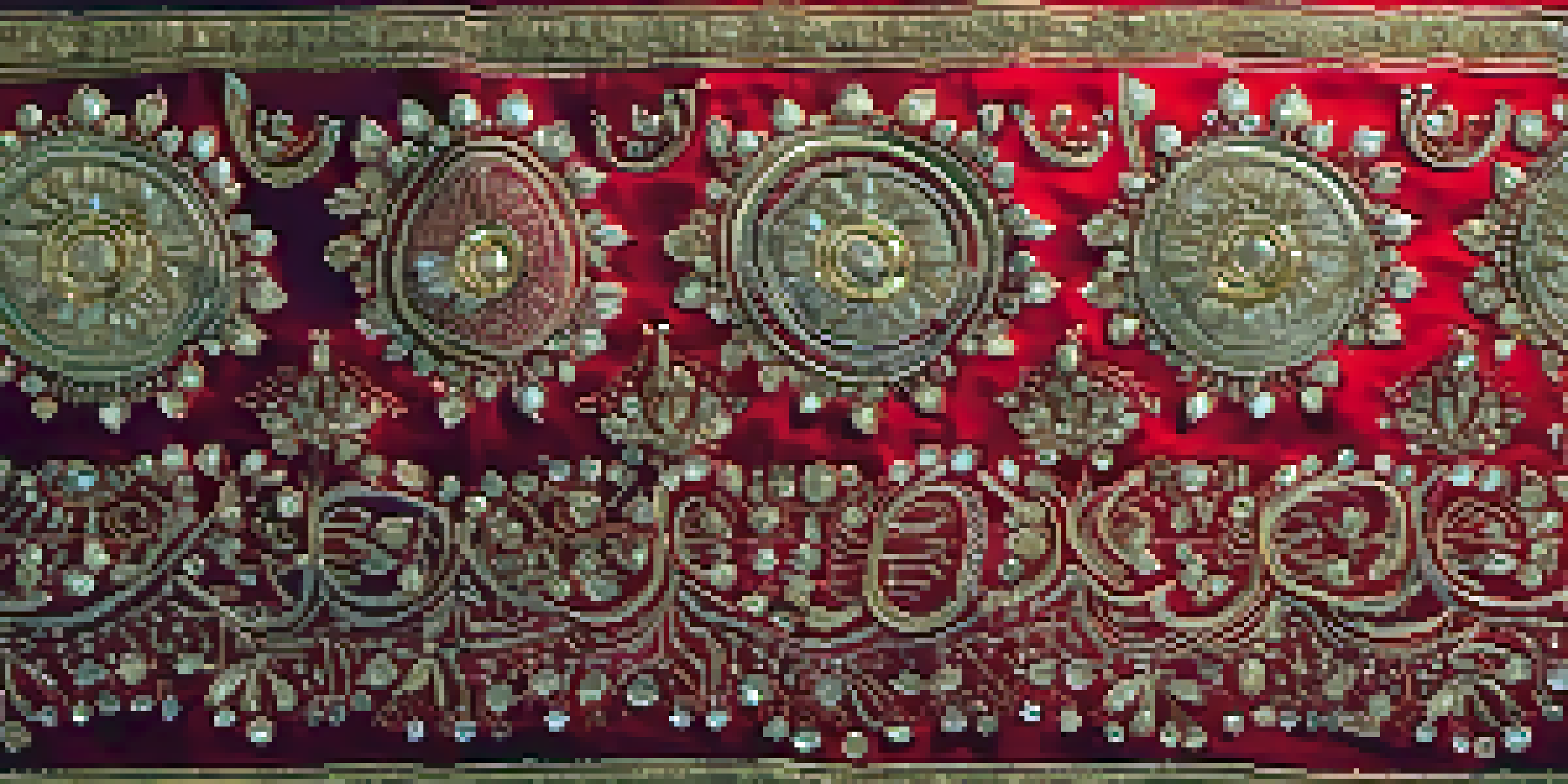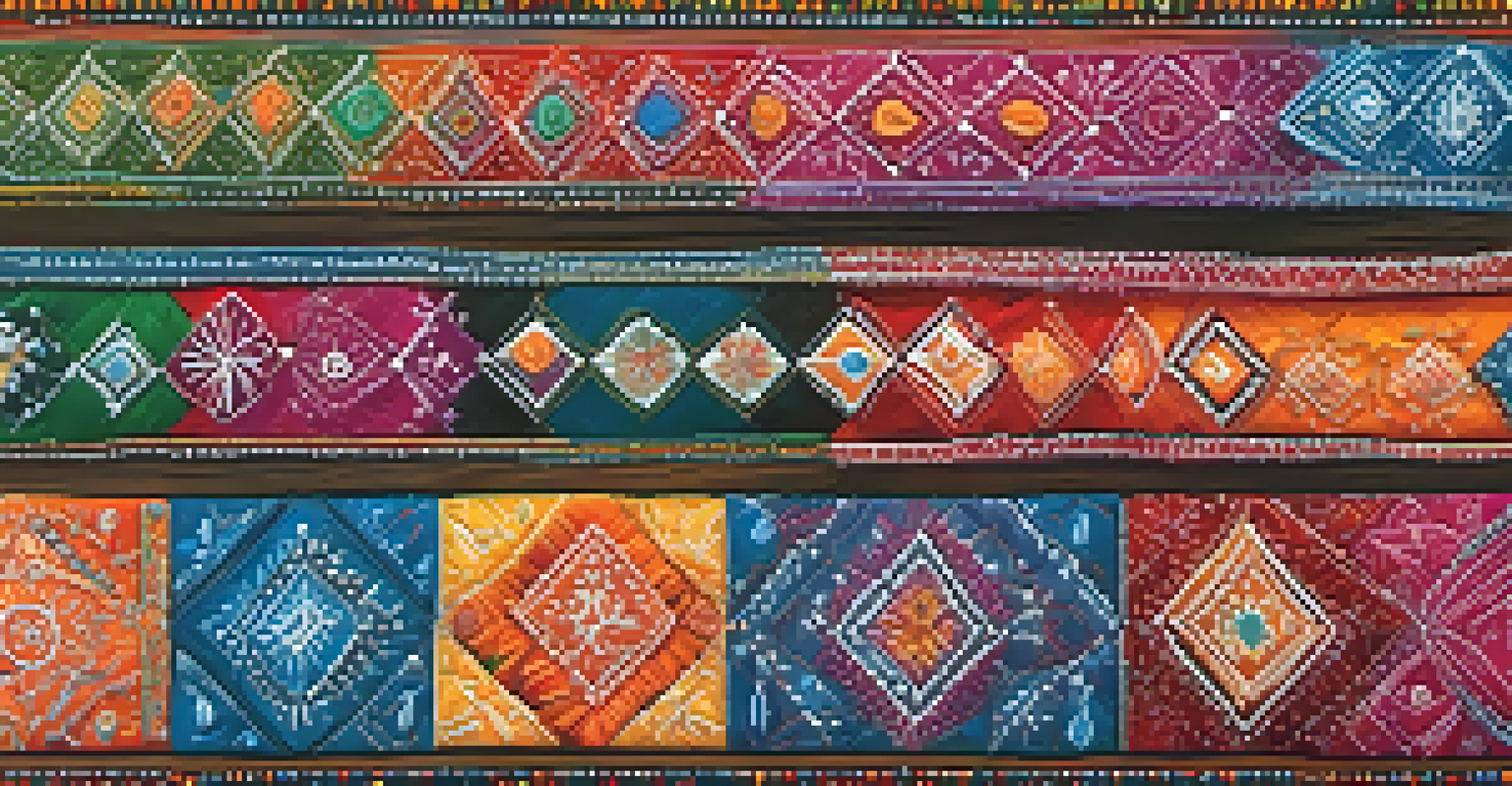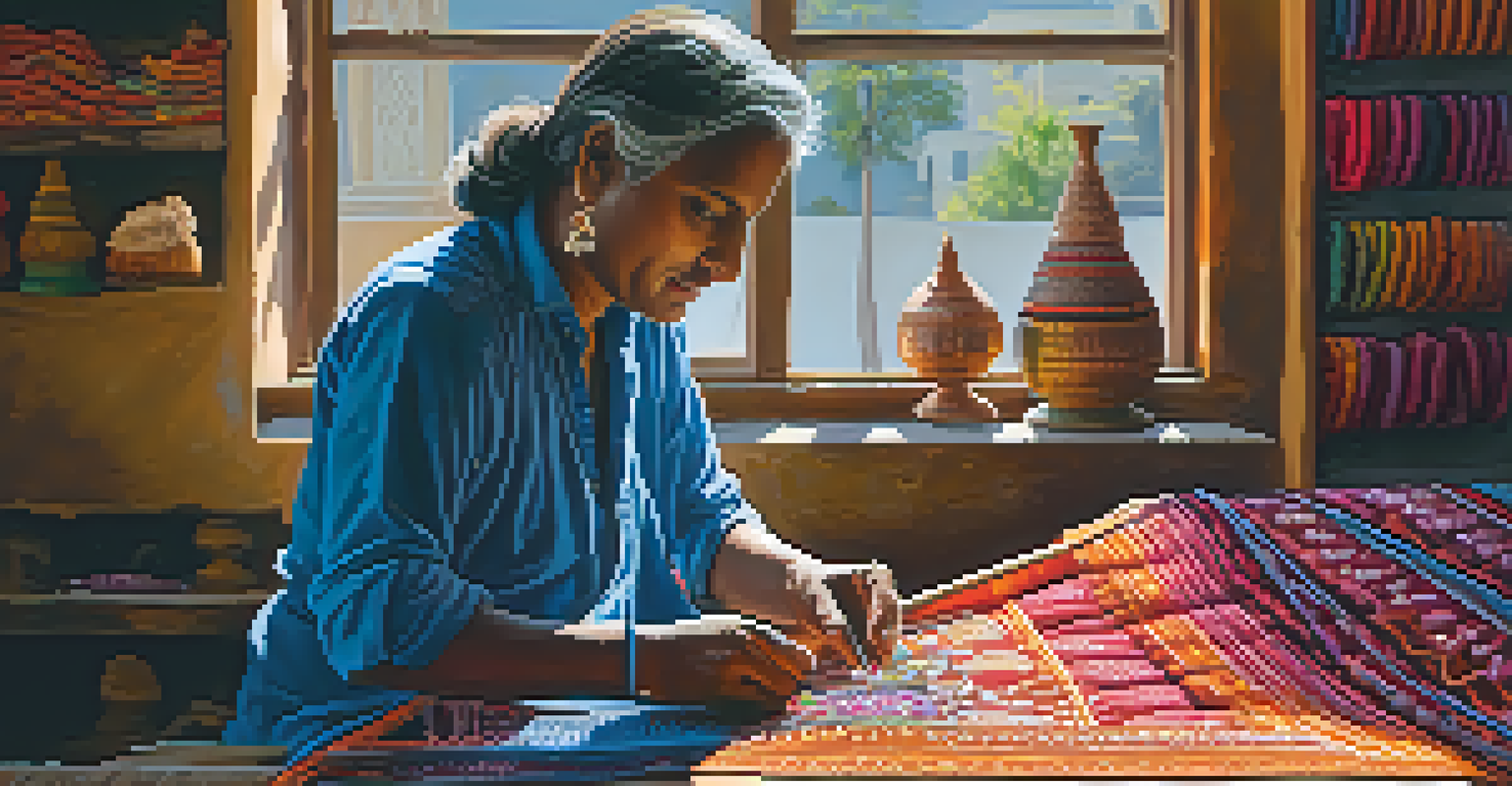Exploring the Intricate World of Indian Embroidery Crafts

The Historical Roots of Indian Embroidery
Indian embroidery has a rich history that dates back thousands of years, intertwining with the diverse cultures of the subcontinent. Each region boasts its unique style, influenced by local traditions, materials, and techniques. For example, the intricate zari work from Gujarat is a testament to the region's royal past, showcasing the craftsmanship that has been passed down through generations.
Embroidery is an art that transcends time and culture, holding the stories of generations in each stitch.
Historically, embroidery was not just an art form but also a means of storytelling, often depicting scenes from mythology or daily life. The Mughal era particularly influenced Indian embroidery, introducing intricate patterns and luxurious materials, which elevated the craft to new heights. This blend of cultures has resulted in a tapestry of styles that reflect India's vibrant history.
Today, the legacy of traditional Indian embroidery continues to thrive, with artisans preserving ancient techniques while also embracing modern influences. As we explore these diverse styles, we'll see how the past informs the present, creating a living history that is both beautiful and meaningful.
Diverse Styles of Indian Embroidery: A Regional Overview
India is home to a plethora of embroidery styles, each as unique as the region it comes from. From the famous chikankari of Lucknow, characterized by its delicate white-on-white stitching, to the bold and vibrant phulkari of Punjab, each style tells a story. These regional differences not only highlight the creativity of artisans but also reflect the cultural heritage of the communities they come from.

In Rajasthan, you’ll find the exquisite mirror work of Banjara embroidery, which incorporates small mirrors into vibrant patterns, adding a touch of sparkle to garments. Meanwhile, the kantha style from West Bengal uses running stitches to create intricate designs and is often made from repurposed fabric, showcasing sustainability in craftsmanship. This variety in styles illustrates the ingenuity and adaptability of Indian embroidery.
Rich History of Indian Embroidery
Indian embroidery has a deep-rooted history that reflects the diverse cultures and traditions of the subcontinent.
As we delve deeper into these regional styles, it's clear that Indian embroidery is a living art form, continuously evolving while staying rooted in tradition. Each stitch is a connection to the past, a celebration of culture, and a reflection of the artistry that defines this timeless craft.
Techniques That Define Indian Embroidery
The techniques employed in Indian embroidery are as varied as the styles themselves, with each method requiring a unique set of skills and tools. Techniques such as satin stitch, chain stitch, and split stitch each create distinct textures and patterns, contributing to the final design's overall look. For example, the satin stitch provides a smooth, glossy finish, perfect for creating floral motifs.
Sustainability is not just a trend; it’s a commitment to preserving our heritage and supporting those who craft it.
One fascinating technique is the use of 'zari,' a fine gold or silver thread that adds a touch of luxury to embroidery. This technique is often used in traditional garments for weddings and festivals, making the attire not just clothing but a work of art. The labor-intensive process of creating zari threads showcases the dedication and skill of artisans, as they carefully weave metallic threads into intricate designs.
Understanding these techniques offers insight into the craftsmanship behind Indian embroidery. Each stitch tells a story of labor, love, and cultural significance, making the finished piece not just visually appealing but rich in meaning and tradition.
The Role of Indian Embroidery in Fashion
In recent years, Indian embroidery has found its way into global fashion, with designers incorporating these rich traditions into contemporary collections. This fusion allows for the celebration of heritage while appealing to modern aesthetics, creating clothing that resonates with a broader audience. For instance, high-end fashion brands often collaborate with local artisans to create unique pieces that highlight traditional craftsmanship.
The resurgence of interest in sustainable fashion has also brought attention to Indian embroidery techniques, as many of them utilize eco-friendly materials and methods. This not only supports local economies but also promotes ethical fashion practices. By wearing clothing that features traditional embroidery, consumers can connect with the artisans’ stories and the cultural significance behind each piece.
Diverse Regional Styles Abound
Each region of India boasts unique embroidery styles, showcasing local creativity and cultural heritage.
As we look to the future, the incorporation of Indian embroidery into fashion signifies a merging of traditions and innovation. It opens up new avenues for artisans and offers fashion lovers a chance to embrace the beauty of handcrafted pieces that carry a legacy of artistry.
Supporting Local Artisans and Sustainable Practices
Supporting local artisans who practice traditional embroidery is crucial for preserving this intricate art form. Many artisans come from rural communities where their craft is a primary source of income. By purchasing handcrafted items, consumers help sustain these communities and keep ancient traditions alive. This support not only benefits the artisans but also encourages the continuation of their craft for future generations.
Sustainability is another important aspect to consider when exploring Indian embroidery. Many of the materials used in traditional embroidery, such as cotton and silk, are natural and biodegradable. Additionally, the practice of upcycling fabric in techniques like kantha contributes to reducing waste, aligning with contemporary sustainable practices. By valuing these traditional methods, we can promote a more eco-conscious approach in the fashion industry.
As awareness grows around ethical consumption, it's essential to recognize the impact of our choices. Supporting Indian embroidery artisans not only helps preserve a rich cultural heritage but also fosters a more sustainable and equitable fashion landscape.
The Future of Indian Embroidery: Trends and Innovations
The future of Indian embroidery looks promising, with a blend of tradition and innovation paving the way for new possibilities. Artisans are experimenting with contemporary designs and techniques while staying true to their roots. This fusion creates a vibrant landscape where traditional craftsmanship meets modern aesthetics, appealing to both local and global markets.
Technology is also playing a role in the future of Indian embroidery. Digital platforms and social media have given artisans a space to showcase their work, connect with customers, and share their stories. This increased visibility not only helps boost sales but also raises awareness about the cultural significance of their craft, fostering appreciation among a wider audience.
Sustainable Practices and Support
Supporting local artisans and embracing sustainable practices is essential for preserving traditional embroidery techniques.
As we look ahead, the key will be balancing innovation with tradition. By embracing new ideas while honoring the rich history of Indian embroidery, artisans can continue to thrive and inspire future generations to celebrate this beautiful craft.
Celebrating the Cultural Significance of Indian Embroidery
Indian embroidery is not just a craft; it is a celebration of culture, identity, and community. Each stitch reflects the stories, beliefs, and traditions of the people who create them, making each piece a unique representation of their heritage. Festivals, weddings, and special occasions often feature embroidered garments, highlighting the importance of this art form in cultural celebrations.
Moreover, embroidery serves as a medium for expressing social and political messages within communities. Artisans often use their craft to address issues such as gender equality, sustainability, and cultural preservation. By weaving these narratives into their work, they contribute to a broader dialogue about identity and heritage.

As we explore the intricate world of Indian embroidery, we come to appreciate its profound significance beyond aesthetics. It is a vibrant tapestry of culture, a testament to the resilience of artisans, and a beautiful reminder of the stories that shape our world.